“Need tips on how to plan Jaisalmer trip? Our guide offers everything you need to know, from itinerary ideas to budget planning and key attractions.”
Table of Contents
History of Jaisalmer
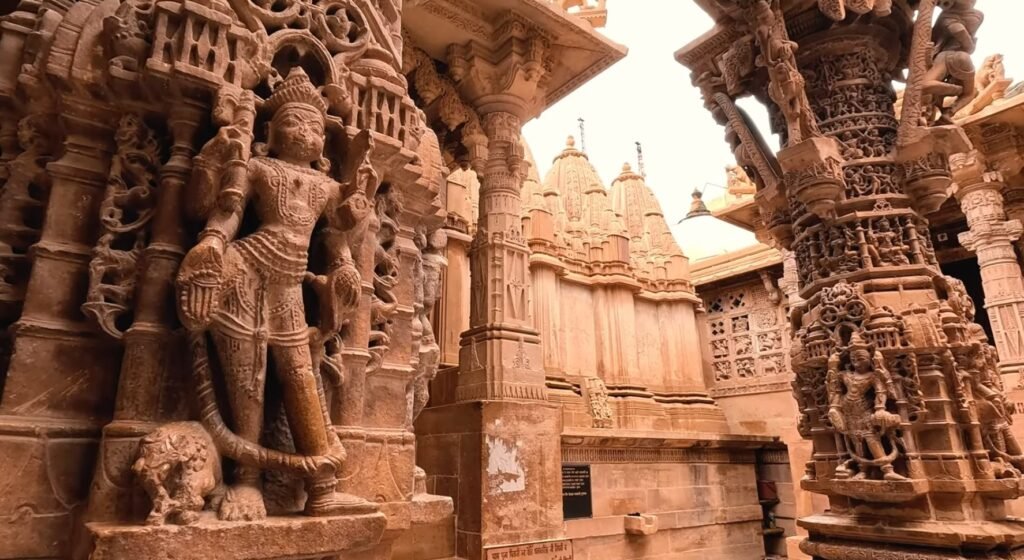
When I visited Jaisalmer, I was impressed by the rich history that surrounds this ancient city. Jaisalmer was founded in 1156 AD by Rawal Jaisal, a Rajput king, after whom the town is named. It was strategically located on the trade route connecting India to Persia, Egypt, and Arabia.
Due to this Jaisalmer became a hub for traders dealing in silk, spices, and other goods, and the wealth from these trading days is still visible in the stunning architecture of the city.
During my visit to Jaisalmer, I quickly understood why it’s known as the “Golden City” of India. Located in the heart of the Thar Desert in Rajasthan, the beautiful yellow sandstone buildings glow under the sunlight, giving the entire city a golden look.
So, Jaisalmer isn’t just a destination for me; it’s an experience that offers a blend of history, culture, and adventure.
Why to visit Jaisalmer

When I visited Jaisalmer, I discovered a city unlike any other—known as the “Golden City,” Jaisalmer Fort that rises above the desert landscape. Walking through its narrow streets, you get a sense of history, as the fort is still home to many local families, shops, and temples. It’s not just a monument; it’s a living part of Jaisalmer’s culture.
Places like the Patwon Ki Haveli and the Gadisar Lake added to the charm of the city, each with its unique stories and history.
Another memorable experience I had i.e. the vast Thar Desert. Taking a camel ride into the Sam Sand dunes at sunset was an unforgettable adventure. The dessert spread as far as your eye could see, and the changing colours of the sand in the evening light were truly magical.
Spending a night in a desert camp under the stars was a peaceful experience for me.
Best time to visit Jaisalmer: my experience
When I planned my trip to Jaisalmer, I knew I had to visit during the winter months, from October to March. Trust me, this is the perfect time to explore the “Golden City.” The weather is cool, and you won’t have to deal with the desert heat. I remember the temperature being around 20°C during the day, making it comfortable for sightseeing and desert activities.
One of the best parts of visiting Jaisalmer in winter was the Jaisalmer Desert Festival. I visited in February, and the city was full of energy. The camel races, traditional folk music, and vibrant dances really brought the place to life. If you’re a culture lover like me, this festival is something you should not miss.
Avoid summers:
once considered visiting in summer, but after hearing about the temperatures reaching up to 45°C, I’m glad I chose winter. It’s not just about the heat – even walking around Jaisalmer Fort or enjoying a camel ride would be tough for you.
I’ve heard some travellers prefer the monsoon season (July to September) for minimal crowds, but honestly, the winter experience of Jaisalmer is unbeatable. The cool breeze in the desert and the golden view of the Thar Desert under the winter sun were memorable for me.
My suggestion:
If you want to truly enjoy Jaisalmer, I’d recommend going between October and March. It’s the ideal time to explore the city’s history, culture, and desert beauty without being bothered by the harsh summer heat.
How to reach Jaisalmer
getting there was quite easy for me. I just took a flight to Jodhpur, which is the nearest airport, about 285 km from Jaisalmer. From there, I opted for a taxi, but there are also buses available for a more budget-friendly option.
Jaisalmer itself has an airport but the flight connectivity from here to major cities is less as compared to Jodhpur.
you can take a train directly to Jaisalmer Railway Station, which is well-connected to major cities like Delhi and Jaipur.
For those who enjoy road trips, the highways connected to Jaisalmer are in good condition, and the drive through the desert is a quite experience.
My suggestion:
If you love to drive, then I suggest you visit Jaisalmer by road because while driving you can also enjoy the golden scenes of deserts…
Best places to visit in Jaisalmer/what I see in Jaisalmer
During my trip to Jaisalmer, I explored many beautiful places that truly show the beauty and history of this golden city. Here are some of the best places to visit in Jaisalmer, each with its own unique experience.
1. Jaisalmer Fort (Sonar Quila)

Jaisalmer fort
My adventure began at the Jaisalmer Fort, also known as Sonar Quila or the Golden Fort. This massive fort looks like it rises from the desert sands and is one of the few living forts in the world, with people still living inside its walls. Built-in 1156 AD by Rao Jaisal, the fort is a UNESCO World Heritage Site and offers a magical glimpse into Rajasthan’s royal past. Walking through its narrow lanes, I was impressed at the ancient architecture, the golden sandstone buildings, and the skilful carvings on the walls.
Inside the fort, there are Jain Temples and several havelis (mansions) with beautiful carvings. I also visited the Raj Mahal, where the royal family once lived. Don’t miss the fort’s viewpoints, which offer panoramic views of the entire city, bathed in golden colour, especially at sunset.
Timings: 9:00 AM to 6:00 PM
Entry Fee: ₹50 (Indian tourists), ₹250 (foreign tourists)
2. Patwon Ki Haveli
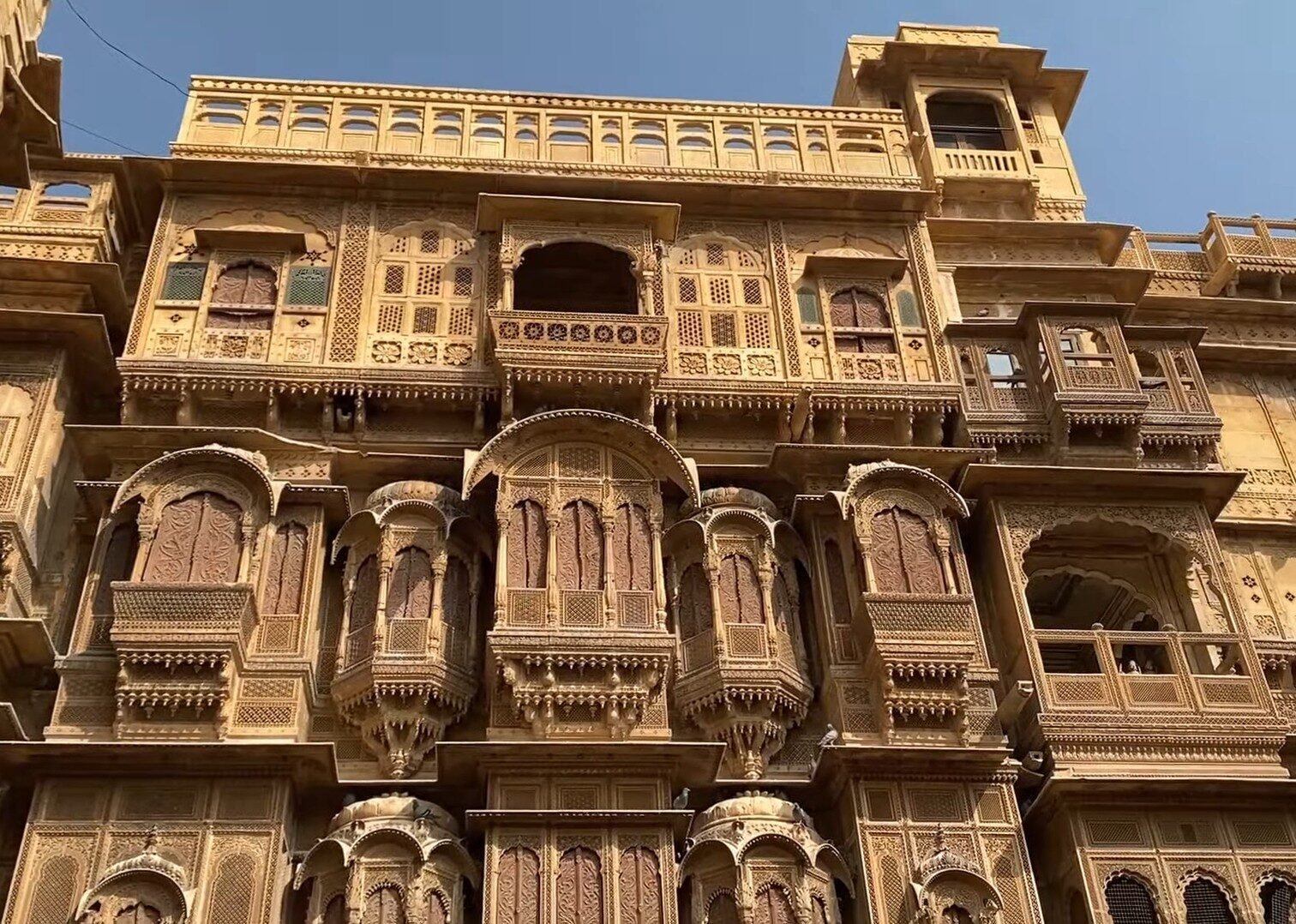
Patwano ki Haveli
Next, I visited Patwon Ki Haveli, one of the most beautiful havelis in Jaisalmer. This cluster of five havelis was built by Guman Chand Patwa, a wealthy trader, and it’s known for its elaborate architecture. Each haveli is intricately carved, with detailed jharokhas (balconies) and beautiful courtyards. Inside, the rooms are filled with antique furniture, paintings, and mirrors. It’s like stepping back in time to the grandeur of a bygone era.
Do you know: that time it takes nearly 60 years to complete the construction of this beautiful architecture?
The haveli also has a museum showcasing artefacts from Jaisalmer’s history and culture, making it a great stop for history lovers like me
Timings: 9:00 AM to 5:00 PM
Entry Fee: ₹50 (Indian tourists), ₹200 (foreign tourists)
3. Sam Sand Dunes

A view of Sam Sand Dune
One of the highlights of my trip was visiting the Sam Sand Dunes, about 40 km from Jaisalmer. This is where you truly experience the desert, with the vast spread of golden sand dunes. I took a camel safari during sunset, and it was one of the most memorable moments of the trip. The sun setting over the dunes creates a magical glow, and the camel ride through the peaceful desert was both thrilling and calming.
In the evening, the desert camps near Sam Sand Dunes come alive with Rajasthani cultural performances, including folk dances and music. I stayed in one of the desert camps, where we enjoyed traditional food and watched the stars twinkling in the clear desert sky.
Timings: Open all day
Best Time: Sunset for camel rides, evening for cultural performances
4. Gadisar Lake

A view of Gadisar Lake
Another peaceful spot I visited was Gadisar Lake, located somewhat outside of Jaisalmer. This man-made reservoir was built by Maharawal Gadsi Singh in the 14th century and used to be the city’s main source of water. Today, it’s a popular tourist spot, surrounded by temples, shrines, and chhatris (cenotaphs).
I took a boat ride on the lake, which was a serene experience, especially during the early morning hours. The lake is also home to many migratory birds, making it a great place for birdwatching. The intricate Tilon ki Pol, a gateway built over the lake, is a must-see for its beautiful architecture.
Timings: 8:00 AM to 8:00 PM
Entry Fee: Free (₹10-₹50 for boating)
5. Kuldhara Village
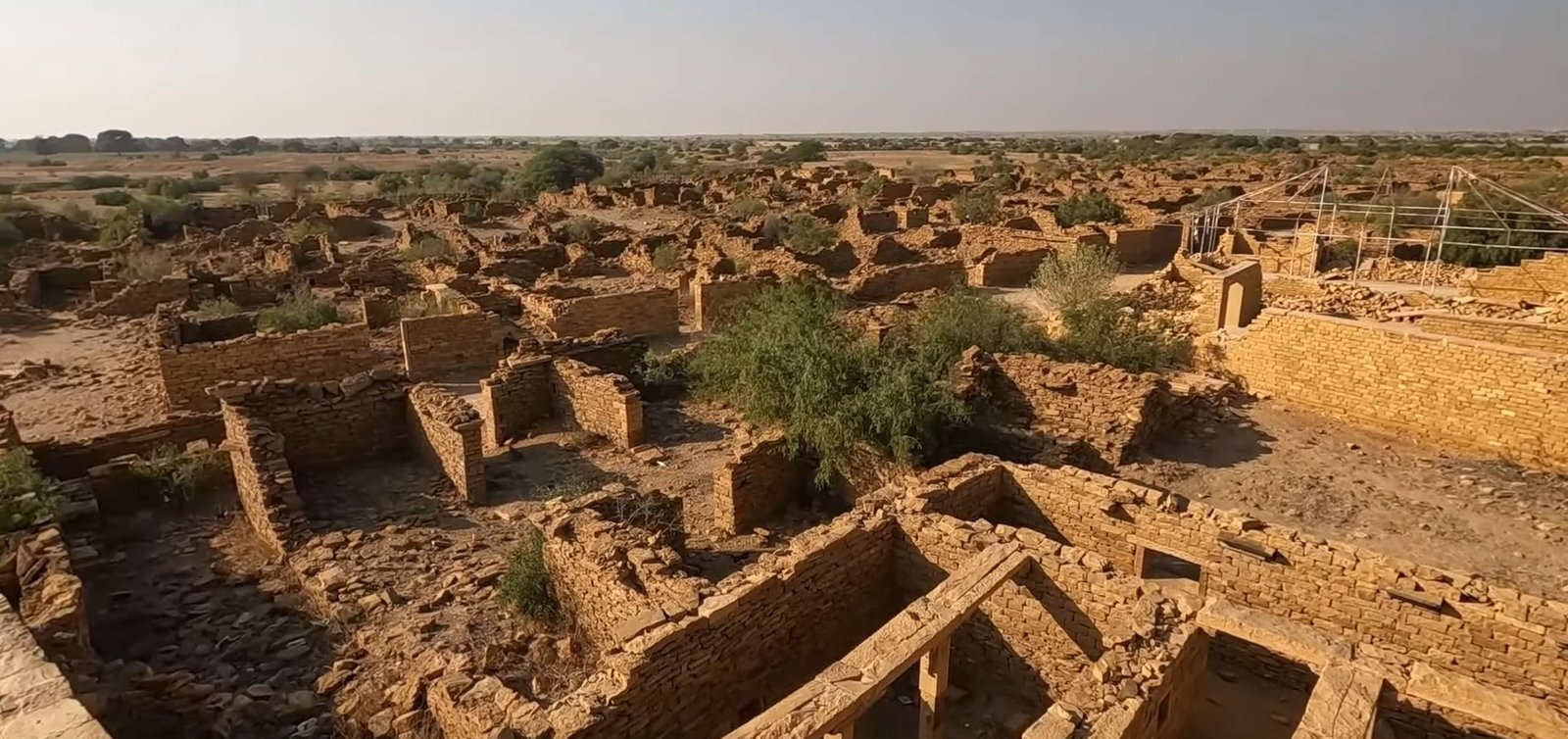
A view of Kuldhara village
For a touch of mystery, I visited Kuldhara, an abandoned village about 18 km from Jaisalmer. I heard from local people that the village was cursed by its inhabitants before they left it overnight, and since then, no one has been able to live there. Walking through the deserted streets of Kuldhara, I felt a mysterious silence, but the village’s architecture is still fascinating.
The ruins of houses, temples, and wells give you an idea of what life must have been like here centuries ago. Kuldhara is now a protected heritage site, and it’s a great place for photographers or anyone interested in history.
Timings: 8:00 AM to 6:00 PM
Entry Fee: ₹10
6. Bada Bagh
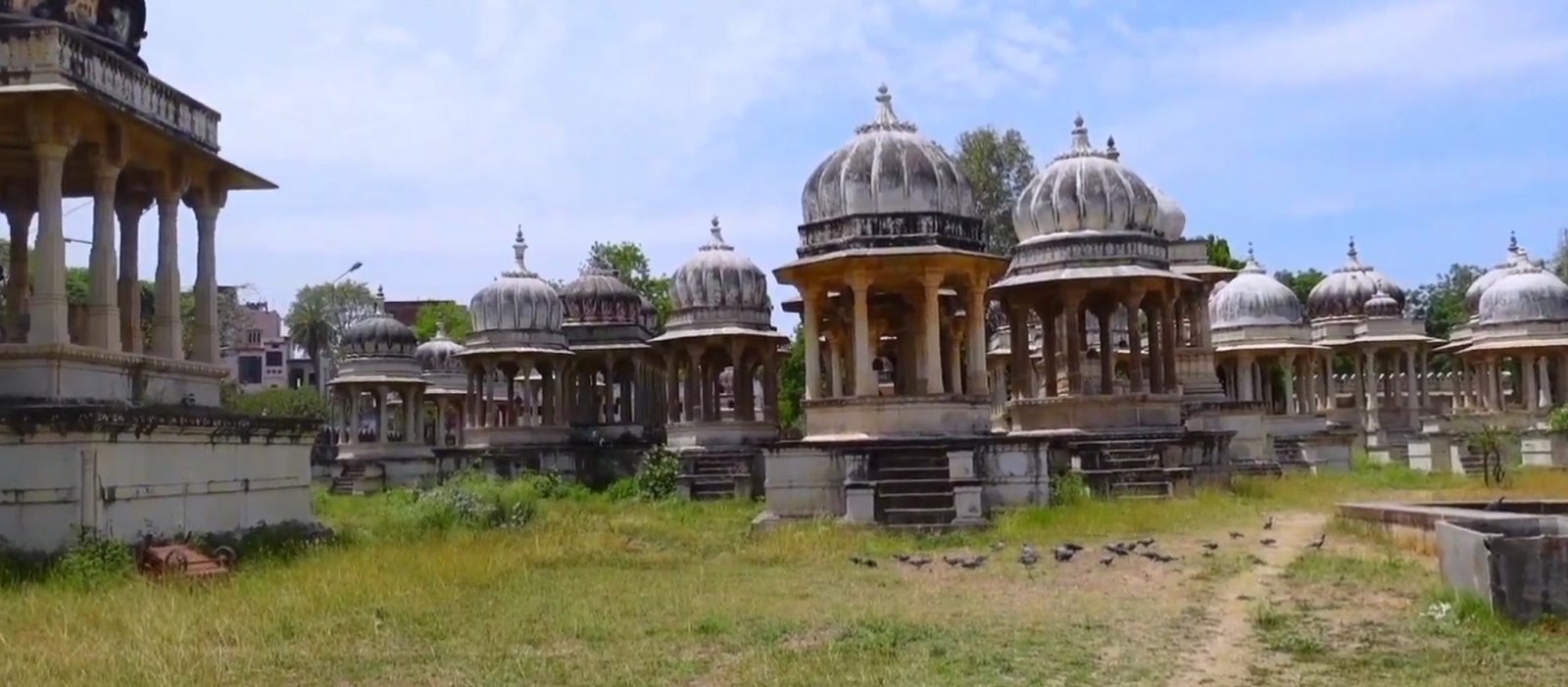
A View of Bada Bagh
One of the most peaceful places I visited was Bada Bagh, a garden complex located about 6 km from Jaisalmer. The site is known for its cenotaphs, or royal chhatris, built in honour of Jaisalmer’s kings. Each cenotaph is very carefully and precisely carved, and the golden sandstone structures look especially beautiful during sunrise and sunset.
Bada Bagh is surrounded by desert landscapes and windmills, which makes it a unique blend of nature and history. The silence here was calming, and it was a perfect spot to reflect and enjoy the beauty of Rajasthan’s royal past.
Timings: 9:00 AM to 6:00 PM
Entry Fee: ₹50 (Indian tourists), ₹100 (foreign tourists)
7. Jain Temples
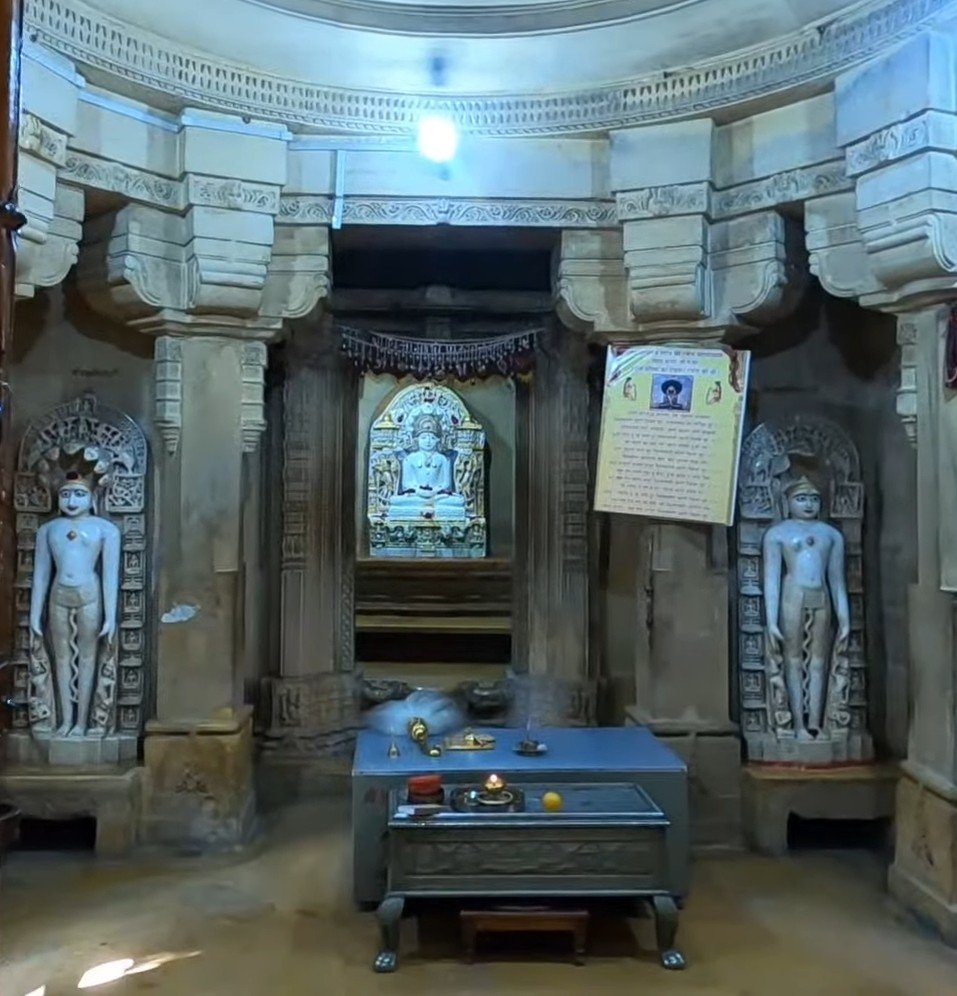
A view from the main entrance of Jain Mandir
Located within Jaisalmer Fort, the Jain Temples are a must-visit for their architectural beauty and spiritual significance. These temples date back to the 12th century and are dedicated to different Jain Tirthankaras. The temples are known for their priceless carvings, beautiful sculptures, and peaceful atmosphere.
I was amazed by the detailed carvings on the walls, which depict scenes from Jain mythology. The temples are a serene place to visit, and even if you’re not religious, the architecture alone is worth the visit.
Timings: 7:00 AM to 12:00 PM
Entry Fee: ₹10 for Indians, ₹30 for foreigners
One Special Tip For You:
When visiting Jaisalmer, you may encounter some local people who forcefully offer guide services at certain places. In such situations, I suggest that you won’t need a tour guide when exploring the Jaisalmer Fort unless you specifically want to learn in-depth about its history. Otherwise, it’s better to avoid such people.
Here’s a tip to help you avoid them: if you’re driving to Jaisalmer in your own vehicle, I recommend parking your car at your hotel and taking an auto-rickshaw to visit the various places. This is because as soon as these guides or agents spot your car, they may surround it and confuse you.
What to eat in Jaisalmer.
Trying the local Rajasthani food was one of the highlights. The city offers a variety of traditional dishes that you must try. One of my favourites was Dal Baati Churma, a signature Rajasthani dish. The baati (round bread) is served with spicy lentils (dal) and a sweet churma, and it’s a filling and flavorful meal that really gives you a taste of local cuisine.
I also loved Ker Sangri, a unique desert vegetable dish made from dried beans and berries, cooked in spices. It’s a bit different from anything I tasted before, but definitely worth trying if you want something authentic.
Another dish that grabbed my attention was Laal Maas, a spicy mutton curry. It’s quite fiery, but if you enjoy bold flavours, you’ll love it. I paired it with Bajra Roti (millet bread), which balanced the heat perfectly.
For snacks, I tried Pyaaz Kachori and Ghotua Laddoo, both of which are popular in Jaisalmer. The kachori was crispy and stuffed with onions and spices, making it the perfect street food to try while exploring the city. Ghotua Laddoo is a sweet made from gram flour, ghee, and sugar, a treat I brought home as a food item.
If you enjoy sweets, don’t miss Mawa Kachori, a dessert kachori filled with rich mawa and nuts. It’s a must-try for anyone who loves sweet dishes.
In Jaisalmer, the food is as rich and colourful as its culture. Whether you’re eating at a local restaurant or from a street vendor, every meal is an authentic experience for me.
Where to stay in Jaisalmer
During my trip to Jaisalmer, finding the right place to stay was key to making the experience special. The city offers a variety of options, depending on your budget and the kind of experience you’re looking for.
If you want to fully embrace the desert vibe, I recommend staying in one of the desert camps. I stayed at a camp in Sam Sand Dunes, about 40 km from the city. The experience was magical – sleeping under the stars, waking up to the golden desert, and enjoying cultural performances around a bonfire in the evening. Most desert camps also offer camel safaris and jeep rides through the dunes.
It’s the perfect way to feel connected to the desert, and there are camps available for every budget, from luxury tents to more affordable ones.
For those who prefer staying within the city, Jaisalmer has some fantastic heritage hotels. I spent a night at Gorbandh Palace, a beautiful hotel built in traditional Rajasthani style. Staying here made me feel like I was living in a royal palace! The rooms were spacious, the service was great, and the views of Jaisalmer Fort from the rooftop were stunning.
Many of these heritage hotels are converted havelis (mansions), and they give you a real sense of the city’s history and culture.
If you’re on a budget, there are plenty of guesthouses and hostels near Jaisalmer Fort. I met some travellers who stayed at Zostel Jaisalmer, a popular option for backpackers. It’s clean, affordable, and offers a great social atmosphere for meeting fellow travellers. Plus, the rooftop has a fantastic view of the fort, which looks especially beautiful when it’s lit up at night.
Another great option for mid-range travellers is Hotel Fifu, located a little away from the busy streets but still close to the main attractions. The hospitality here was warm, and the rooms were comfortable and reasonable.
Whether you want the luxury of a heritage hotel, the adventure of a desert camp, or the community feel of a guesthouse, you’ll find a stay that fits your needs. For me, the mix of spending a night in the desert and another in the city gave the trip a perfect balance!
Cultural programs that I enjoyed at Jaisalmer
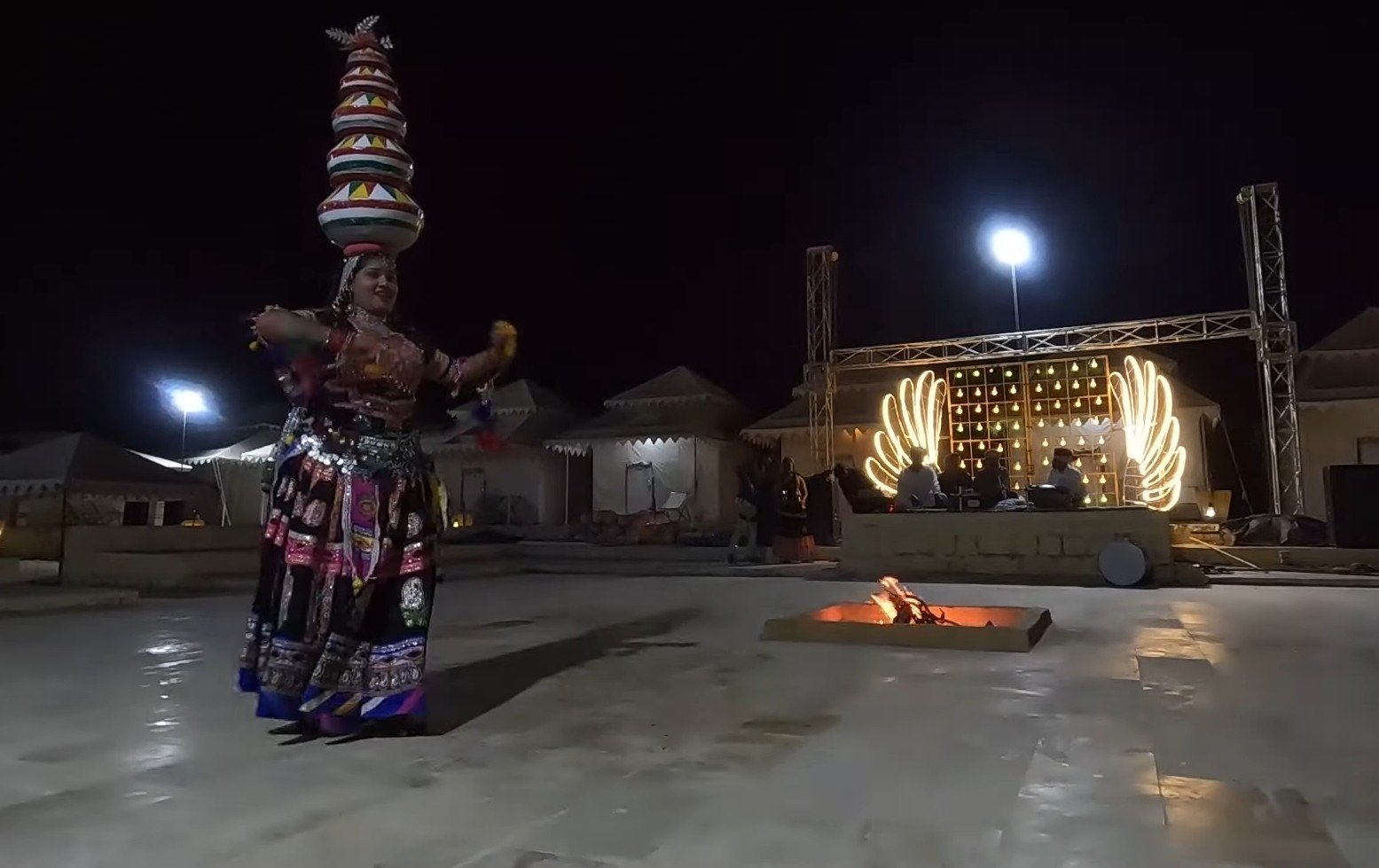
Kalbeliya Dance Performed by Local Lady
During my visit to Jaisalmer, I was really excited to experience the rich culture of Rajasthan. the best way to do this is by attending the many cultural programs the city has to offer. These performances are vibrant and give you a deep sense of Jaisalmer’s traditions, music, and dances.
One of the first things I attended was the Rajasthani folk dance and music performance at a desert camp near Sam Sand Dunes. As the sun set over the golden sands, the locals performed the Kalbeliya dance, a traditional Rajasthani dance, the dancers were dressed in colourful costumes with mirror work, and moved gracefully to the rhythm of the folk music.
The Manganiyar musicians played traditional instruments like the dholak and sarangi, creating an atmosphere that felt very pleasant. It was one of the most authentic cultural experiences I had in Jaisalmer.
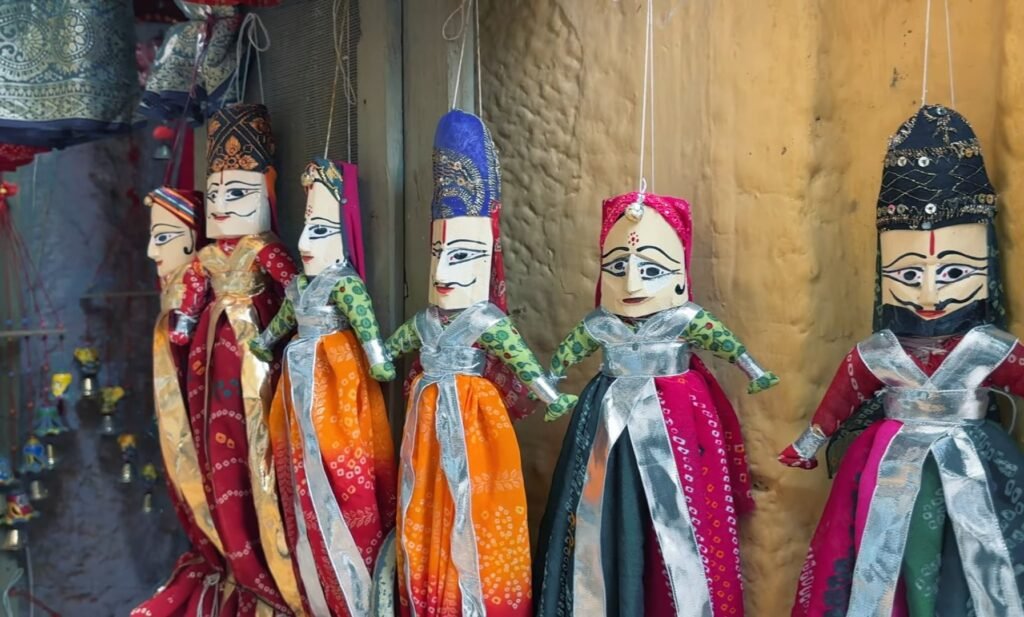
The puppet show
Another must-see cultural experience is the puppet show at the Desert Cultural Centre and Museum. I was surprised at how engaging the puppet show was! The puppeteers told stories about Rajasthani folklore and history, and even though it was simple, it was really funny and gave me traditional Rajasthani entertainment. Plus, the museum itself is full of fascinating artefacts, from textiles to ancient weapons, which adds more cultural value to it.
If you visit Jaisalmer in February, don’t miss the Jaisalmer Desert Festival. The festival includes camel races, turban-tying competitions, and even a contest for the best moustache – something very unique to Rajasthan!
There are also folk dance and music performances throughout the day, showcasing the rich traditions of the desert communities. It’s the perfect time to witness the local culture of Rajasthan.

A kind of adventure show
For a more relaxed evening, you can also attend cultural programs at some of the heritage hotels like Narayan Niwas Palace or Gorbandh Palace. Many hotels organize folk dance and music shows in their courtyards, where you can sit back, have dinner, and enjoy the performances in a royal setting.
I attended one such show, and it was the perfect way to end the day after sightseeing.
Overall, Jaisalmer offers a variety of cultural programs that allow you to experience the culture of Rajasthan. Whether it’s watching a traditional dance in the desert or enjoying a puppet show in the city, the culture here is alive and vibrant, making your trip even more memorable.
What to shop at Jaisalmer
When I visited Jaisalmer, one of the things I was most excited about was shopping. The local markets are filled with beautiful handicrafts, textiles, and items that reflect the rich culture of Rajasthan. I found so many unique items to take home.
One of the first things I bought was a Rajasthani mirror-worked textile. The vibrant colours and precise embroidery on wall hangings, cushion covers, and bedspreads were stunning. If you love home decor, you’ll find a lot of beautiful pieces at Sadar Bazaar and Bhatia Bazaar, two of the main shopping areas in Jaisalmer. The craftsmanship is incredible, and I knew these pieces would add a touch of Rajasthan to my home.
Another great find was jewellery. I’m a fan of silver, and Jaisalmer is known for its silver ornaments. I picked up a few traditional silver anklets and necklaces for my mom, which are not only beautiful but also reflect the region’s artistic heritage. Many of the jewellery pieces here are inspired by tribal designs, and they make for unique gifts.
I couldn’t leave Jaisalmer without buying some local handicrafts. Items like puppets, wooden boxes, and brassware caught my eye. I bought a couple of traditional Rajasthani puppets and they’re a fun reminder of the puppet shows I saw in the city. These handicrafts are perfect for anyone who loves collecting unique items from different places.
If you’re into fashion, Jaisalmer has a variety of Bandhani (tie-dye) fabrics and Rajasthani sarees. I bought a few Bandhani dupattas (scarves) for myself and my sister. The colours were bright, and the craftsmanship was impressive.
Overall, shopping in Jaisalmer was an experience in itself. Every shop and market had something unique to offer, and I ended up with a mix of textiles, jewellery, and handicrafts that will always remind me of my time in the Golden City. Just remember to bargain a little—it’s part of the fun!
Itinerary for 2 Days in Jaisalmer:
When I first arrived in Jaisalmer, the golden city, I had two days to explore its rich history, desert, and unique culture. Though the time was short, I planned my trip carefully to experience the best of this desert land. Let me walk you through how I spent my two days in Jaisalmer and give you tips to make your journey more easy and practical.
Day 1: Exploring Jaisalmer’s Historic Attractions
My day started early, right around sunrise, as Jaisalmer was already bathed in the soft golden light that reflected off its sandstone buildings. I quickly grabbed a local breakfast at a street stall, I tried some hot kachoris with spicy chutney, giving me the energy I needed.
Morning: Jaisalmer Fort
The first spot was the Jaisalmer Fort, also known as Sonar Quila (Golden Fort). It’s hard to describe my feeling of standing in front of this massive fort that seems to rise out of the desert itself.
Built-in 1156 AD, it is one of the largest fully preserved forts in India. The best part? It’s still a living fort. As I wandered inside, I saw narrow streets lined with houses, shops, and temples. The architecture of the fort’s many Havelis left me speechless.
I visited the Jain Temples inside the fort. These temples are known for their precise and accurate carvings, and every inch of these structures tells a story.
Mid-Morning: Patwon Ki Haveli
Just a short walk from the fort is Patwon Ki Haveli, built by a wealthy merchant family. It’s actually a cluster of five havelis, and the craftsmanship here is stunning. As I explored the haveli, I learned about the lavish lifestyle of the merchants who once lived here. I also appreciated the detailed artwork on the walls, the beautiful balconies, and the impressive woodwork.
Lunch: Local Cuisine
For lunch, I decided to choose local Rajasthani cuisine. I found a small restaurant near the fort and ordered a traditional Rajasthani thali, which included dishes like dal baati churma, ker sangri, and gatte ki sabzi. The flavours were rich, spicy, and unlike anything I had ever tasted before.
Afternoon: Gadisar Lake
After a good satisfying meal, I headed to Gadisar Lake, a peaceful spot located on the outside of the city. Built by Maharaja Gadsi Singh, the lake is surrounded by temples and ghats.
I took a boat ride across the lake, which provided a beautiful view of the sunset over Jaisalmer Fort in the distance. The calm waters and the reflection of the golden city on the lake made this a moment to remember for me.
Evening: Sunset at Sam Sand Dunes
No trip to Jaisalmer is complete without experiencing the vast Thar Desert. As the evening approached, I made my way to Sam Sand Dunes, nearly 40 km from the city. The sight of the endless sand dunes stretching as far as the eye could see was a unique experience for me.
I booked a camel ride to take me deep into the desert, and as the sun started to set, the entire landscape was painted in shades of orange and gold. Watching the sunset from the top of a dune was one of the most magical experiences of my trip.
Afterwards, I enjoyed a traditional Rajasthani cultural performance at a nearby desert camp, with folk music and dance under the stars, followed by a warm dinner.
Day 2: exploring Jaisalmer’s Culture
After a night under the desert stars, I woke up refreshed and ready for another day of exploring.
Morning: Bada Bagh
I started my day by visiting Bada Bagh, an old royal cenotaph (chhatri) complex located a few kilometres outside Jaisalmer. This spot, with its cluster of grand cenotaphs, is where the royal family used to cremate after their death. What fascinated me most was how the sunlight played through the empty domes, casting long shadows on the ground. It felt like walking through history.
Mid-Morning: Thar Heritage Museum
Next, I visited the Thar Heritage Museum, a small but well-curated museum that offers a look into the history, culture, and traditions of the Thar Desert region. The museum is home to artefacts, costumes, and even fossils from the area. It was a great way to learn about the desert way of life.
Lunch: More Rajasthani Delights
For lunch, I wanted to try more local food, so I visited another traditional restaurant. This time, I opted for Ker Sangri, a tangy Rajasthani dish made from wild desert beans, along with bajra roti. Once again, the flavours were intense, and I enjoyed every bite.
Afternoon: Kuldhara the Haunted village
In the afternoon, I made my way to the abandoned village of Kuldhara, located around 18 km from Jaisalmer. According to some local people, this village was mysteriously deserted overnight by its natives more than 200 years ago.
Walking through the ruins of this village was very fascinating. The crumbling walls and silent streets told their own story.
Evening: A Walk through the Markets
For my last evening in Jaisalmer, I spent time wandering through the local markets. I picked up some items like colourful textiles, handmade jewellery, and miniature paintings.
The shopkeepers calling out and locals going about their business, felt like the perfect end to my trip.
Conclusion:
My time in Jaisalmer was filled with rich history, incredible sights, and unforgettable experiences that will stay with me forever. From exploring ancient forts and havelis to experiencing the thrill of the desert dunes, there’s something here for every member of your family.
The city’s speciality lies in its ability to transport me to another era, where l can walk through ancient streets, admire beautiful architecture, and feel the spirit of Rajasthan’s desert culture.
If you’re working on how to plan Jaisalmer trip, make sure to explore these incredible places – each one offers a unique experience of this “golden city.”
How to plan Jaisalmer
trip: FAQ
I recently visited Jaisalmer, and here’s a quick FAQS on how to plan Jaisalmer trip for anyone planning their trip to this beautiful desert city.
1. How many days do I need to explore Jaisalmer?
For a relaxed trip, 2 days are enough. During my trip, I spent two days exploring the major attractions, including the Jaisalmer Fort, Patwon Ki Haveli, and the sand dunes in the Thar Desert. If you want to enjoy a camel safari and stay at a desert camp, you’ll need at least two nights.
2. What is the best time to visit Jaisalmer?
I went in November, which was perfect. The best time to visit Jaisalmer is between October and March. The weather is pleasant and ideal for sightseeing. Summers are extremely hot, so I’d recommend avoiding the months from April to June.
3. How to reach Jaisalmer?
You can take a train from Jodhpur to Jaisalmer, which is the most convenient route if you’re travelling within Rajasthan. Jaisalmer is well-connected by road and rail. If you’re flying, you can land in Jodhpur and then take a bus or taxi to Jaisalmer, which is about a 5-6 hour drive.
4. What should I pack for a Jaisalmer trip?
I packed light, comfortable cotton clothes for the day and some warm layers for the evening. Even though it’s hot during the day, the desert can get quite chilly at night. Don’t forget sunscreen, sunglasses, and a hat to protect yourself from the sun. Comfortable walking shoes are also a must for exploring the fort and the havelis.
5. Best places to visit in Jaisalmer?
The Jaisalmer Fort, also known as Sonar Quila, is a must-visit. I also explored the intricate Patwon Ki Haveli and Nathmal Ki Haveli. Don’t miss the Gadisar Lake for a peaceful sunset. And of course, spending a night in the Thar Desert, doing a camel safari and stargazing, was the highlight of my trip.
6. What is the estimated budget for a Jaisalmer trip?
For a budget trip, I spent around ₹15,000-21,000 for 2 days. This included accommodation, food, transport, and desert camp activities. There are plenty of options from budget to luxury, so it’s easy to adjust according to your budget.
I hope this helps you plan your trip to Jaisalmer! It’s truly a magical experience.

